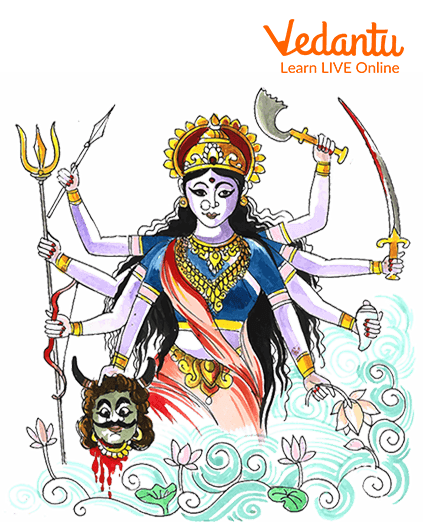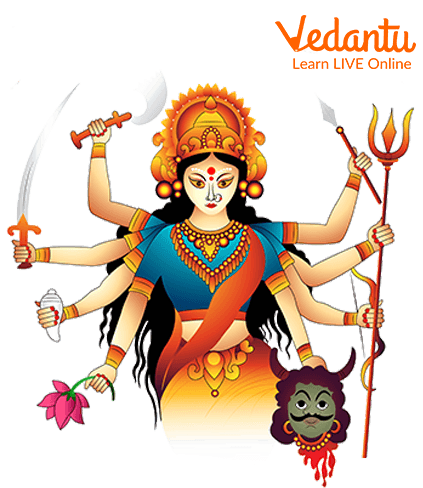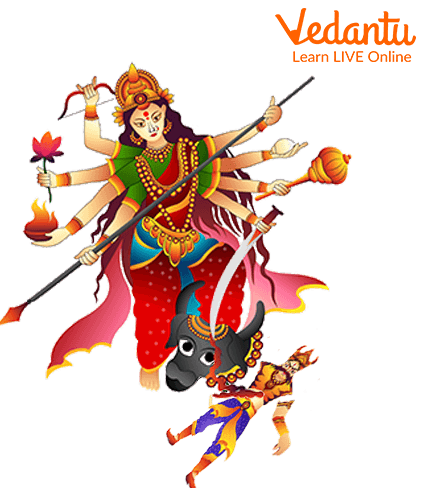Story of Kali

The Hindu goddess Kali, also known by many names like Mahakali, Bhadrakali, and Kalika, is seen in Shaktism as the personification of all power, time, destruction, and change. She is viewed in this religion as a fierce manifestation of Mahadevi, the greatest power or ultimate reality. She is the first of the Hindu tantric tradition's ten Mahavidyas. The following are the takeaway points from this topic:
How was the goddess Kali Created?
Story of Kali
Kali Goddess Story
Introduction to the Story of Kali
Hindu mother goddess Kali, also known as the Great Deity Devi or Sati, Rudrani, Parvati, Chinnemastica, Kamakshi, Umak Meenakshi, Himavati, and Kumari, is the furious manifestation of this goddess (also known as Durga). She is a complex symbol which is both admired and dreaded.
She has been described as both violent and caring since she is linked to the contrasting forces of creation and redemption and death and destruction. She serves as a reminder of the inevitable nature of death, which fosters acceptance. She is a guardian who is frequently invoked during calamities and epidemics. She is also a goddess of fertility and time. She is a metaphor for productivity since she embodies the natural cycles and may also be seen as a perpetual creator who takes life to give it to others. In her role as destroyer, Kali puts an end to anything in the way of a person's purity and tranquillity, both in life and in death, like evil, ignorance, and egoism. The Sanskrit word for "time" that makes up Kali's name denotes her presence.

Goddess Kali
How was the Goddess Kali Created?
The Kali Goddess Story is fascinating to know. Kali is frequently depicted standing over Shiva, the Hindu god of destruction, with one foot on his leg and the other on his breast. This posture hints in the story that he threw himself under her to halt her destructive rampage. The feminine counterpart to Shiva, Kali is thought to be the formless spirit of Shiva's destroying forces. Together with Shiva, they stand for dynamism and the duality character of the universe because they are frequently shown dancing or in a sexual position.

Kali
Kali Goddess Myth
One early creation tale of Kali involves Durga/Devi, who made Parvati, a stunning and collected goddess, to aid in battling and taming demonic spirits. Parvati confidently charged into battle when faced by the demons, but she furrowed her brow and her wrathful form, Kali, appeared. The fierce warrior Kali swallowed several of the demon heads in her large mouth in addition to beheading them and giving them to Durga. Because of this, Kali is frequently seen wielding weapons, clutching a garland of skulls, and having her lips covered in blood.

Kali Standing on One Leg on Mahishasura
Conclusion
The Goddess of time, conversion, and devastation are Kali. She is the untamed, strong, and unconditionally loving energy current that flows through you. As with the rich practice of yoga, this energy is intricately entwined with the life, death life cycle to keep you evolving and growing.


FAQs on Story of Kali
1. Does Shiva give birth to Kali?
Parvati, the wife of the powerful Hindu god Shiva, is represented by Kali as the personification of shakti and energy. The most common way that Kali appears in art is as a frightening fighter with a bloody knife and a necklace made of human heads, arms, and tongues.
2. How was Kali created?
According to the Kalki Purana, Kali was born on the twelfth day of the waxing moon fortnight into the family of Sumati and Vishnuyasha in the Shambala hamlet.
3. What are the powers of Goddess Kali?
According to Kalki Purana, Goddess Kali symbolises change, and catastrophic destruction, which is deeply involved in the cycle of life and death.
The Hindu goddess Kali, also known by many names like Mahakali, Bhadrakali, and Kalika, is seen in Shaktism as the personification of all power, time, destruction, and change. She is viewed in this religion as a fierce manifestation of Mahadevi, the greatest power or ultimate reality. She is the first of the Hindu tantric tradition's ten Mahavidyas. The following are the takeaway points from this topic:
How was the goddess Kali Created?
Story of Kali
Kali Goddess Story




